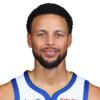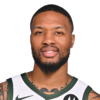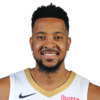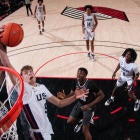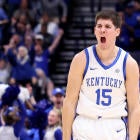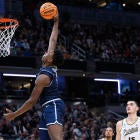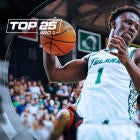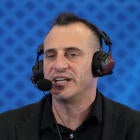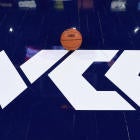Has the NBA ever had so many really good players from so many small schools/one-bid college basketball leagues occupy and enhance its playoffs like this season?
For example, the series between the Golden State Warriors and Portland Trail Blazers -- two of the most offensively minded professional teams around -- features four talented 6-foot-3 guards from far-flung outposts of college basketball:
- Golden State's Stephen Curry from Davidson College (Davidson, North Carolina)
- Portland's Damian Lillard from Weber State University (Ogden, Utah)
- Portland's CJ McCollum from Lehigh University (Bethlehem, Pennsylvania)
- Golden State's Ian Clark from Belmont University (Nashville, Tennessee)
And they're far from the only small-school studs now thriving on playoff teams, as we also have Kent Bazemore (Old Dominion) and Paul Millsap (Louisiana Tech) on the Hawks. Patty Mills (Saint Mary's) with the Spurs and George Hill (IUPUI) with the Jazz. If you want, you could consider Pacers star Paul George (Fresno State) in this regard, too, as he's not from a traditionally relevant basketball program, and Gordon Hayward helped change Butler's national identity after he enrolled there.
Let's stick with Golden State-Portland, though. Sure, three of the four players (except Clark) were lottery picks. But the fact they became lottery picks is why this is so intriguing. Even after going in the top 10, Lillard, McCollum and Curry all have exceeded expectations. And I wonder: Would these guys have been this good had they been able to land in a power conference or at a top-50 program? Perhaps, but there's no guarantee.
We've grown so accustomed to Curry's world-twisting wizardry and Lillard's All-Star-level powers that perhaps the fact those two guys have become household NBA names via unlikely college avenues is old hat. For me, I'm continually entertained by that fact. And through the lens of college basketball, and historic NBA superstardom, it's still fairly outstanding.
Here are three common threads with all four players:
1. Each of them played at least 100 games in college and started as a freshman
This cultivated a confidence and sense of responsibility that allowed them to be prepared not just to play, but to adapt quickly at the NBA level. It also helped the quartet of players more grow more quickly than if they'd gone to a top 50-type program and been on the bench, or a fourth or fifth option as freshmen.
"I liken the game of basketball to a Broadway show," Davidson coach Bob McKillop said. "Steph was put in the leading role as a freshman. He had to learn the steps, tunes, the recitation of lines. The more he was doing that, the better he would get at it."
2. They all were the best players in their respective conferences for most of their college careers
Curry was a two-time Player of the Year winner in the Southern Conference. Same for Lillard in the Big Sky and McCollum in the Patriot League. Clark was the Ohio Valley POY his senior season. When looking for the next possible small-school breakout player, they're almost certainly going to have to have proven themselves as the best in their league.
"He's one of those guys, similar to Lillard, I don't know what his ceiling is because he keeps breaking through it," former Lehigh assistant Matt Logie, who discovered McCollum, told me.
3. Each player's coach said they had a humility about them that, combined with a competitive edge -- a reason to prove they were under-recruited -- served then as it serves now as necessary fuel for on-court success.
Each of their coaches told me their player was raised right and came from good parents. This allowed them to have a humble attitude about being recruited by any school in the first place. Every coach told me none of these four players had any entitlement about them. But the fact they weren't recruited by bigger programs, it wound up helping them, too.
"He was no icon, just a Belmont basketball player," Bruins coach Rick Byrd said of Clark. "He was a great teammate, we were just really lucky. You're really lucky when your great players have great attitudes as opposed to when you have guys who think they're better than everybody else, decide when they want to work in practice and everything."
In light of Golden State and Portland squaring off for the second year in a row in the NBA playoffs, I reached out to each player's college coach (all of them are still at the same school as when they coached the players at hand) to talk origin stories. Let's flash back to when they were in tiny gyms, almost all their games weren't on television and the NBA was truly a dream, not an impending reality.
A big appeal to all of these players is where they came from. Here's how it all began for Clark, Curry, Lillard and McCollum.
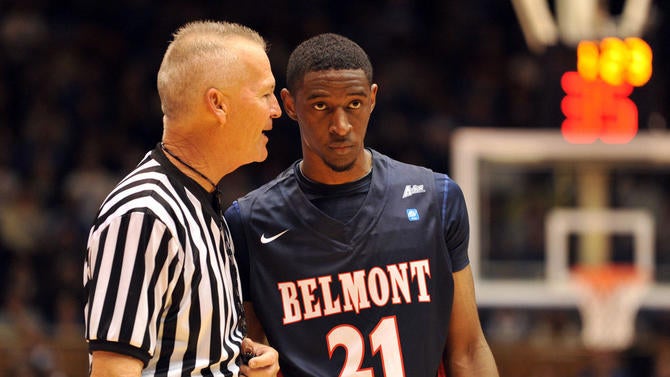
How Clark wound up at Belmont
Then-Bruins assistant Roger Idstrom was the first to find Clark and clue Rick Byrd in about the sinewy shooting guard. Of the four players highlighted here, Clark was by far the deepest pull. He was barely drawing interest from any school, and only Middle Tennessee eventually pursued him as aggressively as Belmont. Clark's Germantown (Tenn.) High School team played a tournament in Nashville, and that's how Belmont got in. Clark was a four-year player in college who made more NCAA Tournaments (three) than any of the other guys. He's also the one with the simplest story. Belmont got in early, he committed with confidence and trust, and that was that.
Belmont coach Rick Byrd: "There was hardly any contact from NBA teams. Scouts would call randomly to ask who was good in our league. 'Do you have a kid?' That kind of stuff. Alex Renfrow had interest. Ian didn't stand out more than any other player. He earned it. He had a great career here, there's no question about that, he played three years in the Atlantic Sun, one year in the OVC, and we won seven of eight possible conference championships, including regular season and tournament, and he was the best player. His college career, he's as good a D-I player as we've had."
Clark was defensive player of the year in the OVC, but Byrd admitted that his ability "just did not compute" with him in regard to how good he'd be at the NBA level.
Byrd: "Ian's very quiet, he has great humility, he was raised right. Great parents. He had a lot of pride in his basketball. You have to coach everybody fairly, but you probably coach 15 guys 15 different ways to some degree. He had a lot of pride in how good he was, but it was better for me to pull him to the side and say, 'You didn't get to the help there like you needed to.' Me calling him out in front of other people, that wasn't the tactic that was best for him. We went 30-5 when he was a sophomore, he played 24 minutes, was the best player on the team but willing to sacrifice those minutes."
Belmont, under Byrd over the decades, has made a habit of turning interesting recruits into eventual MVPs in league play. Clark went from being ranked outside the top 400 in national recruiting databases to being a two-time league Player of the Year and a Summer League MVP. That was the performance, after he went undrafted, that launched him onto an NBA roster.
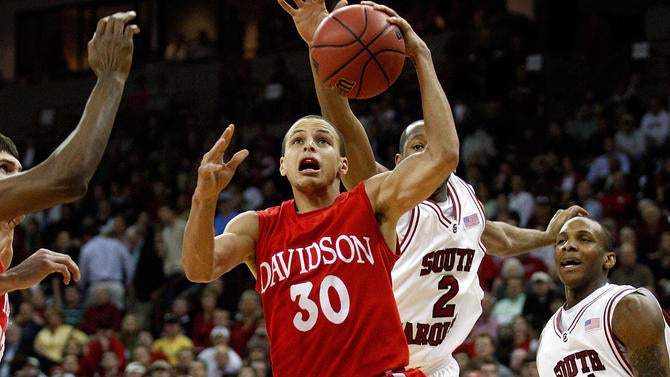
How Curry wound up at Davidson
The infamy of Virginia Tech not offering a scholarship to Curry has been a narrative of his career for almost a decade now. Curry's father, Dell, attended the school. But due to Stephen's slight frame and widespread doubt among every major-conference coaching staff, he never was viewed as a realistic prospect at that level. What's not as well-known is how long Davidson coach Bob McKillop had known Stephen.
Davidson coach Bob McKillop: "You grow up in Charlotte and your father is a legendary figure and not just in NBA basketball but in the community. Stephen played with my son on an AAU baseball team when they were 10, and they won a championship. We watched baseball on the weekends with the Currys, March through May. They were on the Charlotte Heat. I got to see Steph as a competitor, a tough little bugger, and so of course he's in my mind. Then you see him got to Charlotte Christian (High School). I pick up the newspaper, as I'm someone who reads the newspaper, and he's putting up some numbers. Yes he was slight of frame, short, baby-faced, but there were things he did.
"I don't remember the first time I saw him play, but I think he might've been younger, because I was looking at an older guy on his team. Steph caught my eye at that point, though. He was on the list and possibly a scholarship option down the road. The main reason is we have a penchant for recruiting sons of ex-players. I've always thought genetics played a big factor with development. They're in the gym watching their father work out, practice, at shootaround. Father watches games at home on TV, goes in the backyard and shoots with [his son]. All of these are factors.
In Stephen's junior year of high school, McKillop officially offered him a scholarship. Come July, the staff was closely following him, and it was during one of his worst moments that McKillop was sure they had the right guy.
McKillop: "We're in Las Vegas. You know how you've got the big gym and the small, aux gym? Steph is in the aux gym, his dad was the coach and Steph wasn't good in that game. As you always do as a college coach, you look around and see who else was recruiting. No one was there. Stephen was awful. He was throwing the ball into the first row of the stands, he's losing the ball out of bounds on the dribble, but the whole time he made these mistakes, he never once stopped competing, never once went to a huddle and had his head down and sulked. He just had this constant face of competitive toughness, and this is as a 17-year-old kid. I thought it was extraordinary. We were more convinced than ever that this was the kid with the right character.
"Wouldn't you know, fast forward, his first game at Davidson was against Eastern Michigan in a game in Ann Arbor. We're down 16 points at halftime. He had eight turnovers, was 1 for 5 from the floor and had two points. Me and my staff talked. 'Remember Las Vegas. He's going to stay with it, so let's stay with him.' He wound up with a double-double: 15 points and 13 turnovers. We won. Then he put up 30 on Michigan the next night and it was full speed ahead from that point on.
Curry committed at the beginning of his senior year, opting for Davidson over Winthrop and Liberty, according to McKillop.
McKillop: "It was a September afternoon in Charlotte. During the conversation, 20 minutes in, he said, 'Coach, I've made my decision and I'm going to Davidson.' His mother's parting words to me: 'Don't worry, I'll fatten him up,' and I said, 'Don't worry, I'll take him just the way he is.' It was a warm, sunny afternoon that became warmer and sunnier."

How Lillard wound up at Weber State
While playing at Oakland High in California, Lillard wasn't being recruited by anyone in D-I as late as January of his junior year. His AAU coach called Weber State coach Randy Rahe and implored him to take a look.
Weber State coach Randy Rahe: "Damian was awful on the phone. I just couldn't get anything out of him."
Rahe doubted Lillard was even interested, judging off the phone call. But he tracked him, the staff watched Lillard in Houston in April of his junior year. He looked so good, Rahe thought they wouldn't have a chance. They offered him immediately. Eventually, bigger schools began to offer.
Rahe: "In the fall, when he took visits, Damian wouldn't just jump on anything. He was very careful about his visits, going to Saint Mary's, and in October we had another kid we could get. I said, 'Damian, you have to come visit now or I have to take this other kid. So he says, 'All right, I'm going to talk to my mom. This was late October. He came, and mom really liked it. He got home on Sunday, then we did an in-home visit with like 50 people in the house. Cousins, aunts, everyone you can imagine. It was on the outskirts of Oakland, a suburb, not a well-to-do family, in a tough area. A very small house near the Oakland airport. Damian didn't come from much. What he did have was terrific parents. They weren't together but they were both involved. I was getting ready to leave and his mom asked me to stay for 10 minutes."
The house was packed. Rahe didn't know where Damian was, so he was just going to quietly shuffle off.
Rahe: "Then Damian comes in, puts his arm around me and whispers in my ear that he was going to Weber State. Damian slow-played the recruiting process, wouldn't commit to visits. His big deal in recruiting: He had to trust the people. He wanted to go somewhere he knew he'd play as a freshman and somewhere he wanted to win. I didn't know we were getting a pro. Sh— I think he's gotten better; I probably held him back. But anyway, that's the story."

How McCollum wound up at Lehigh
There's a famous picture of a young McCollum looking so small he looked like a different species while on the floor with other big-time high school players. He was discovered by former Lehigh assistant Matt Logie. McCollum was at GlenOak High in Ohio, close to Kent State, where Logie had previously been an assistant.
Former Lehigh assistant Matt Logie: "I was on the old HoopMasters recruiting website that didn't require a huge fee to join. Lehigh didn't have a huge budget, we'd get updates on kids from around the Midwest. It was November of C.J.'s junior year in high school. I saw a game recap article of his first varsity game of his junior year. He had 52 points. If someone can score 52, I thought I should at least call and get his transcripts. He was a good student, so he was then on our radar."
It would be another five months before Logie and Lehigh coach Brett Reed saw McCollum in person, at the HoopGroup tournament at West Virginia University in the spring of McCollum's junior year.
Lehigh coach Brett Reed: "That's when I made probably the understatement of my career: 'He can really help us.' The traffic around C.J. was not that strong although he played in front a lot of big coaches and programs, with a prominent program (LeBron James' AAU outfit), he wasn't a coveted prospect."
Logie: "At that time he wasn't infamously small, like the picture, but he was about 6-1 and maybe 150 pounds. Looked like a young, late developing combo guard that hadn't hit his growth spurt but had a skill set in terms of his ball-handling, feel and shooting. It sounds weird to say now, but he reminded me of a poor man's Steph Curry. This was the same time Steph was hitting the radar at Davidson. I liked him right away because we were looking for a combo guard. Programs would normally be all over him, but because of his size, few were on him. He visited St. Francis PA and Lehigh was the only official he took. Boise State talked to him. I had a buddy in Ohio pleading with (former Boise State coach Greg Graham) to take him, but McCollum didn't play well in that game in Las Vegas. It's the end of July, he's undersized, a little fatigued. I was thrilled. I remember walking out of the gym and calling another assistant and saying 'I think he went 3 for 14. It couldn't have gone any better."
For Reed's in-home visit, the power went out due to a bad thunderstorm.
Reed: "I remember going into the house, and there were candles. We had a really cozy night just at the kitchen table talking to each other. A candlelight dinner with no food and no romance but a lot of love for C.J."
Logie: "Every time I called C.J. he was either going to the gym, in the gym and asked to call me back, or had just left the gym. I remember being impressed by it then, and it continued when he got to Lehigh. He had the vision when he was 16. I never would've believed he could be where he is today. But my pitch to C.J. was to be the next Steph Curry. Lehigh needs you, will invest in you, and give you the maximum opportunity to develop and find exposure.'"
By the numbers
Finally, let's look at the numbers. The average national recruiting ranking for these four guys: 345th. Astonishing.
Clark might seem like the black sheep of the group, because he's not a starter, but he did drop 36 on San Antonio earlier this season, and if you've been watching Golden State as of late, he's getting more and more playing time. He'll be landing a nice contract with some team this summer. Book it.
Also, McCollum and Lillard combined to average 50.0 points this season, the highest of any backcourt in the NBA. Not bad for a pair of dudes from the Big Sky and Patriot League.






